Eye of the Beholder – Numbers
Statistics are great as you can use them to reduce complex issues to a number. In case the number does not match your expectations, you can adjust either the collection (questions, people, form) or the interpretation until it works for you. When a number is prominently displayed, be sure to check the motivation behind it. Lets look at some prominently communicated numbers.
5 million ABAP developers
A few numbers have circulated in the SAP developer world in the last months. One was the number of 5 million ABAP developers worldwide.
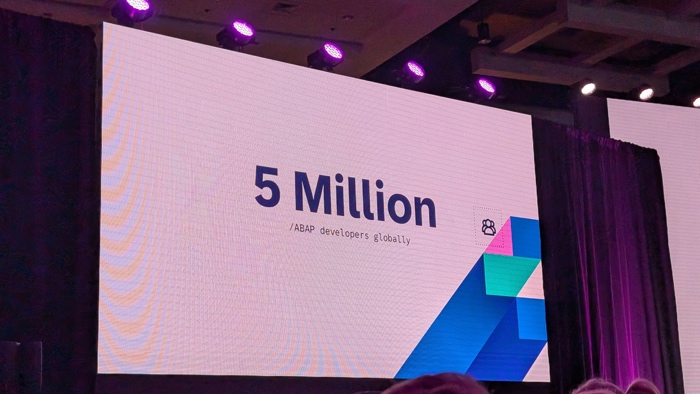
5 million. Impressive. One number on a single slide. This gets the attention of the audience. And yes, congratulations, it worked. Is 5 million an impressive number? Looking at the numbers available here: yes. It states that there are worldwide 19.6 million developers. Another site states there are 28.7 million developers worldwide. Java (6.2 /17 million) and JavaScript (5.8 / 20 million) have the most developers. There is a significant discrepancy between these numbers. Nevertheless, 5 million ABAP developers would be a significant share in both cases. Considering however that ABAP is not even included in both statistics: how can they miss 5 million developers? It depends on factors like motivation or data collection. Take the TIOBE index: no ABAP in the top 20. Even COBOL is ranked at 20. ABAP is on place 39. That’s the equivalent of having your site placed on Google search result page #8. If you know how the rating is calculated, and know how ABAP developers work: the ranking is not a big surprise.
But … how to conclude there are 5 million ABAP developers worldwide? Did someone count them? Is the number based on the developer keys emitted? I do have several developer keys at my employer. Throughout the years I got dozens of developer keys from several companies. Do I count as one person? What about S/4HANA developers? Is it based on the number of people that put ABAP dev in their LinkedIn profile? Were customers and partners asked how many ABAP developers they have on their payroll? Is it the number of BC400 attendees over the decades? As an alternative: the number could entirely be made up. Someone thought about the number and wrote it down. There could be less or even 10 times more ABAP developers.
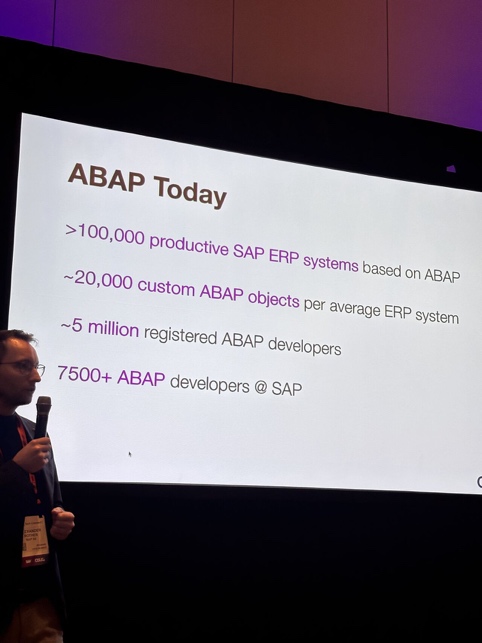
Another slide, same number. Note the ~ in front of the 5 million ABAP developers. It could be less, or more. Also: here it is registered ABAP developers. So … that’s the ones SAP knows exist via developer keys? And 100,000 productive ERP systems. 100,000 ERP systems based on ABAP and 5 million ABAP developers? A question that immediately should come to your mind is: what’s an ERP system? SAP ECC and S/4HANA, for sure. Does this include Business ByDesign?
The 7,500 ABAP developers at SAP … SAP has currently over 109,000 employees. Their core business is standard software and their main product for this is S/4HANA. Basically, S/4HANA is business processes translated to code. 7% of SAP’s workforce is capable to deliver code that serves their main business? What are the other 93% doing? How many developers at SAP are coding for a SaaS solution based on Java(script)? Regarding the non-ABAP developers at SAP, maybe there are more, but there should be at least the same amount. 15,000 developers at SAP still do not seem right. And the 7,500 ABAP devs cannot be all the people that know how to code ABAP at SAP. The number of people that can translate business processes to code must be higher.
SAP’s half year report lists 35,844 employees in R&D. 7,500 does not look so bad, as employees in R&D includes non-ABAP and other profiles. Maybe 40% are ABAP developers? Who says that in other areas like Services or Cloud and software no one can develop ABAP? 7,500 out of 67,193 does not look so good.
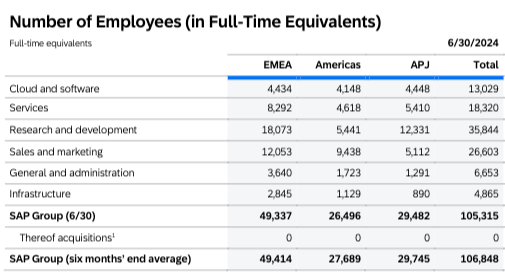
To sum this up: without stating how SAP came up to the number 5 million, the number is just a number. Same for the 7,500 internal ABAP developers. The number comes from SAP, meaning: this is the official number. There are now 5 million ABAP developers.
SAP Community
Let’s put the 5 million into context: SCN. SCN is so nice to publish numbers.
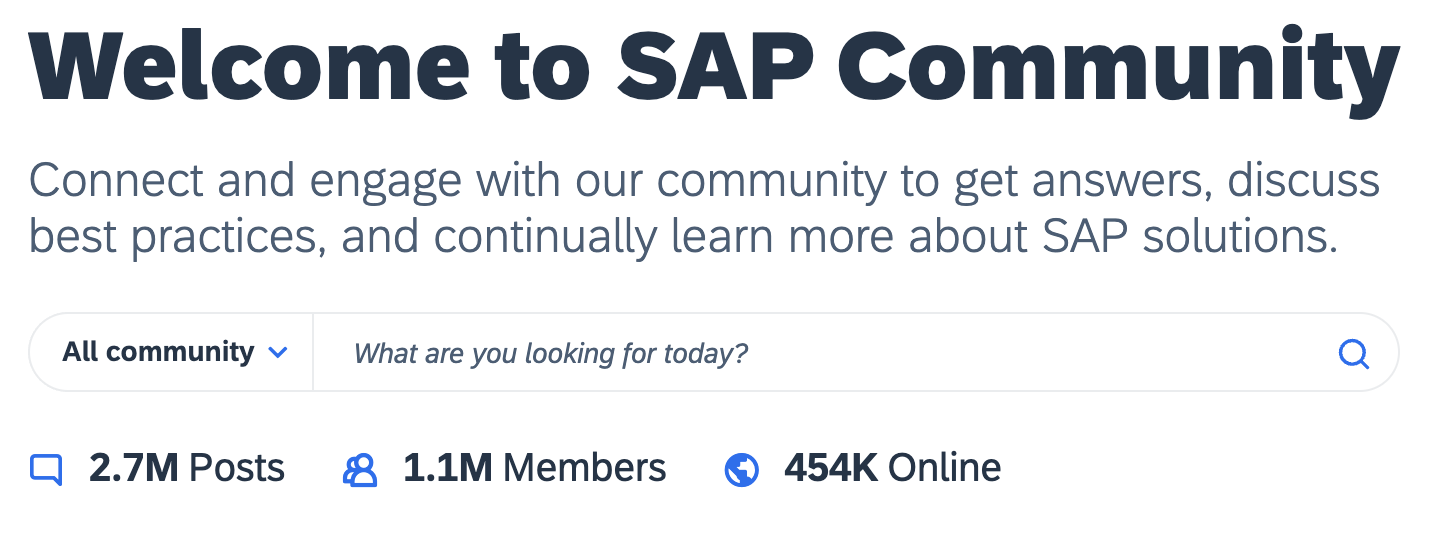
Source (screenshot taken on a Sunday afternoon, around November)
SCN communicated that it has 1.1 million members. 454,000 are online. I doubt that on a Sunday afternoon 454k people are online, so I guess online means: active users that log on from time to time. Otherwise, having 40% of your users online: impressive.
Same screenshot taken a few months later: 1.3M members, 520K online.
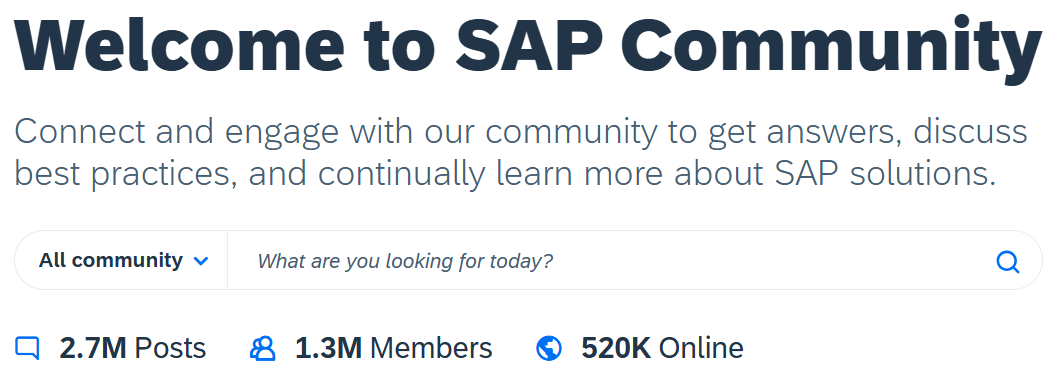
Taking DSA number into consideration which was 406,049 (March 2025): 520K online is even more impressive. Considering not so long ago SCN communicated 21.6k as online, … what an impressive increase. Congratulations! Problem with the DSA number: how does SCN calculate it? I can access SCN from my private phone, laptop, tablet, business phone, laptop, virtual machine. Is this taken into consideration or do I count as 6?
I captured the published DSA numbers since February 2024. Here is the overview of the numbers.
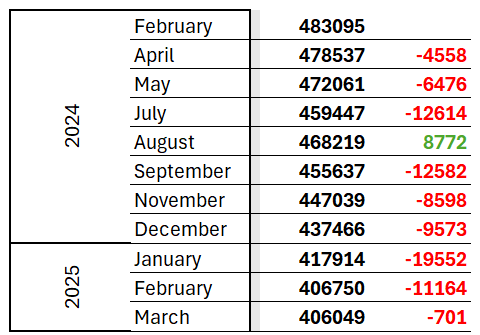
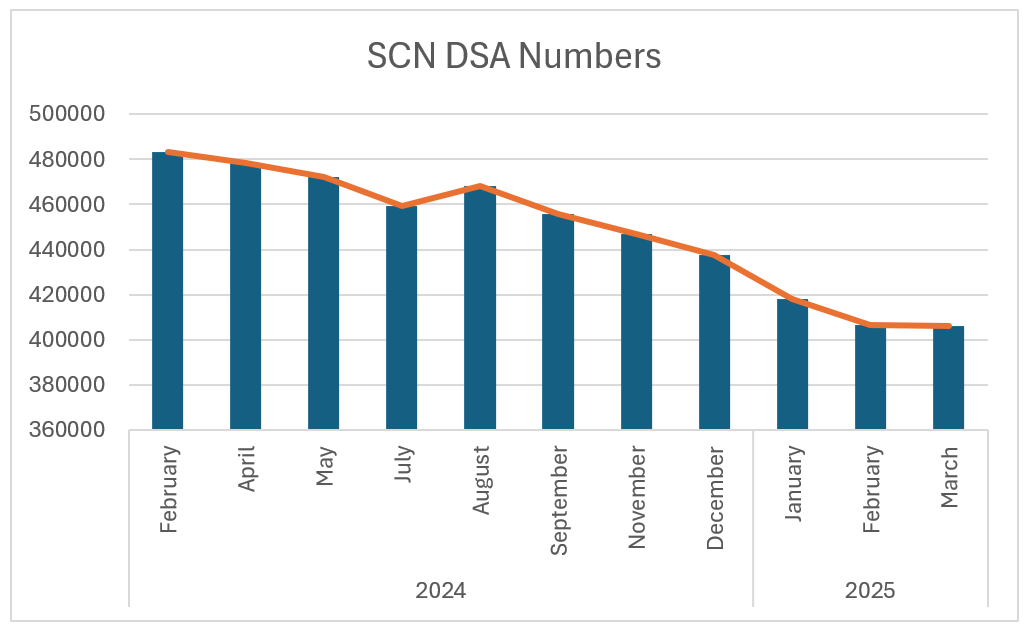
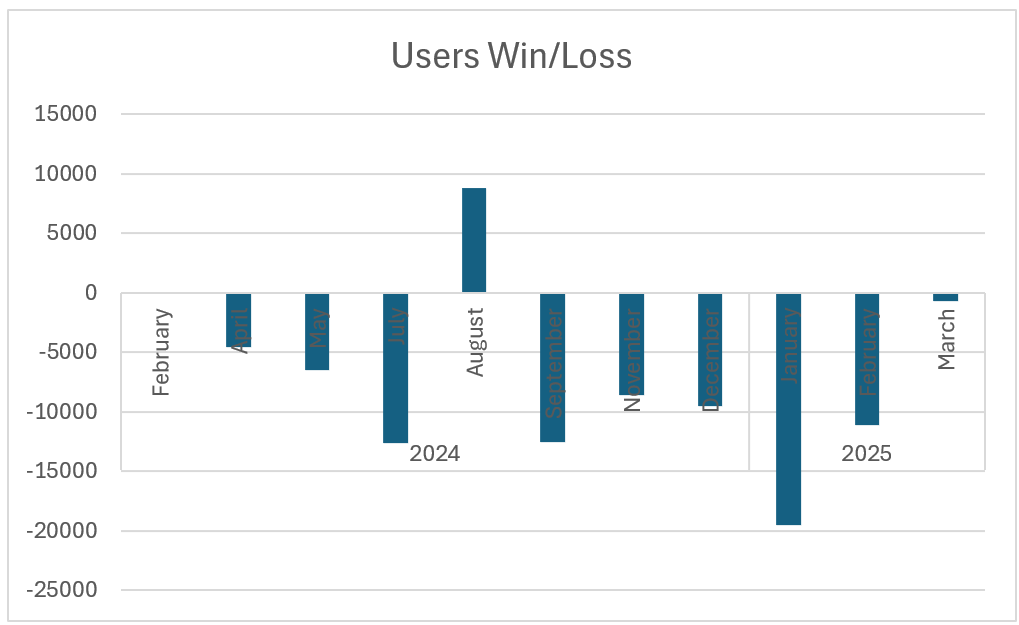
In one year, the DSA numbers show 77,046 less users. As on the homepage SAP shows that everything is OK with SCN: how come? Maybe that’s just for the EU and access numbers are higher in other regions? The members-to-online ratio is impressive. Is the online number the currently online users or the average active users globally per month? 6 months? Made up by a random number generator? The 406k active people from the DSA number are the result after taking into consideration the last 6 months. That’s not the daily users. Looking at my private blog and its statistics: I might not have as much users, but I am closer than I thought. And when my private little blog reaches a user number that is a two digit % share of what SCN has … well, maybe going for groups and UID were not the best choices? Some people responsible for the current state of SCN are no longer working at SAP. I guess it was not the technology after all.
Devtoberfest
Without knowing how the numbers are calculated, it is hard to put them into a meaningful context. Which brings me to the Devtoberfest numbers. Knowing how numbers are gathered is important. This vital part is not transparent here, at least the author is known.. I did not find any information on how the data is captured by Marian, so … let’s hope he will share this in detail in a future post on LinkedIn. As no one complained that the numbers are not correct: they are correct. 600 people reached level 1 of Devtoberfest 2024. The claim that 4,000 people participated is noise. You can earn a badge without doing nothing. The 600 however had to participate actively (sort of).
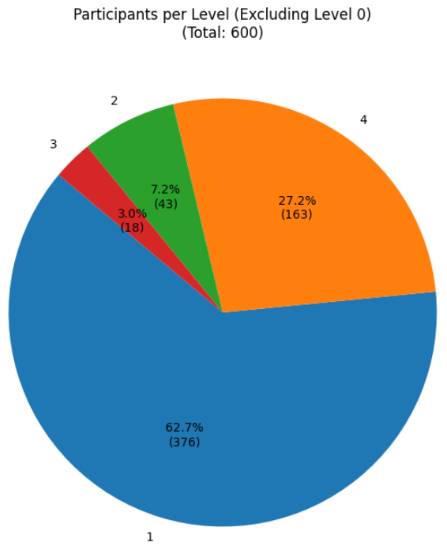
600 active participants for Devtoberfest 2024. Let’s try to put the 600 in context. Devtoberfest is not just a webcast or a simple blog post. It is more than a virtual event by SAP, it is a series of activities targeted at SAP developers. Be it SAP employees, freelancers, students, from partners or customers. Not just ABAP developers, but Java, JavaScript, HANA, frontend, analytics. Everyone can find something. There is budget behind it. Resources, effort, marketing. You can be passive and “just” consume e.g. YouTube videos, or be active, e.g. by completing tasks like participating and finishing a tutorial, and gain badges. 4,000+ people earned a badge, so that’s the number of people that somehow got engaged. Not necessarily active, as you can gain a badge by doing nothing. Need an example? Take me.
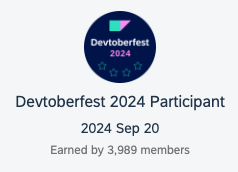
I am a Devtoberfest 2024 participant and I did nothing. Why? For some reason SCN thinks that my password is different than the one I saved in my passkey app after my last password reset. Honestly, I have better things to do than to reset my password SCN decided to change for me. Good news: not being able to log on does not mean that you cannot earn badges. Turns out, I was active.

Therefore, the 4,000+ people earning badges is just a number. 600 is the number you are looking for. Albeit … I should have completed more tutorials before having to reset my password and I’d have made it to level 1. As I did 2023 without being actively engaged.
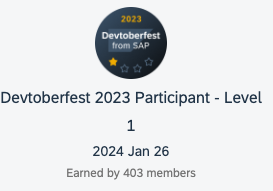
Good news: the badge states that level 1 was reached by 403 members in 2023. I guess the 600 hundred level 1 participants in 2024 counts as an increase. Look at the bright side: 400 to 600 is 200 more people. 50% increase in just one year.
That’s the number of active people. Active … SCN members? SAP developers? Let’s try to put the 600 people in context. 600 from
- 5 million ABAP developers -> 0,0%
- 1.1 million SCN members -> 0,0%
- 454k online SCN members -> 0,1%
600 people participating actively in Devtoberfest … is this worth the effort? As with the previous numbers: you need to be able to put them in context. Was Devtoberfest with 600 active participants a good investment of resources? More people watched the YT videos, which are part of Devtoberfest. The videos view count for the Devtoberfest 2024 ranges from a few hundred to several thousand views. The SAP Developers channel has over 44k subscribers. My guess is that not all potential is fostered. What can be done for 2025? Have 1,000 active participants reach Level 1? 1,000 out of 1.3+ million SCN members? That’s still 0,0%. If you once tried to learn SAP, you know how hard it is to get access to free tier, trial or simple developer friendly systems. I know on which topics I’d put my focus on. So far, I doubt that the elephants (yes, plural, as there are so many things performing badly for years) in the room will be solved, so … 600 is impressive. When engagement numbers are more important than removing obstacles: let’s go for numbers. Looking at the resources available, I’d go for more ambitious goals. 5 million ABAP developers? How about reaching 10%? If one task is to make them develop a RAP application, 500,000 ABAP developers are than enabled to develop RAP with ADT. Too ambitious? Then go for 10% of the 1.3 million SCN users. Or 10% of the active users. That would still mean to engage with 40,000 users. Not so easy? Well, then eliminate barriers: ensure UID works and is not a pain to use. Make it easier to go through the tutorials (include demo systems and/or the exercises). Provide ready-to-use environment and systems. Include SAP learning (win one of x LH subscriptions, get a certification voucher for free) and SAP Partners (do a coding challenge at partner X). Do on-site, hybrid events. The list can go on and on. Instead, celebrating 600 active users is the goal to reach?
Numbers
Official communicated numbers serve a purpose: to transmit a message. To make yourself or your goal look good. 5 million ABAP developers can mean that you are not alone. Or better: show to (potential) customers that they will find enough people with the desired ABAP skill in the market. That there is a market for developers and ABAP based solutions. It means that ABAP is something you cannot ignore. The 7,500 ABAP developers at SAP are there to transmit the message that ABAP is alive inside SAP, that it is important for SAP and that it is used to build their main ERP product: S/4HANA.
It is easy to write down a number and publish it. Context is important. When context is missing, consider to ignore the number or ask why the number is communicated at all. Regarding the SCN numbers: one purpose is to make SCN look alive (context: Stackoverflow reports in March 2025 below 12 million users) and worth joining and participating. The 600 celebrated active participants for Devtoberfest? I have no idea why. 600 does not look good and I have no idea when this would be good.

2 Comments
Thomas Jung · March 13, 2025 at 14:09
Some details about Devtoberfest. I can’t speak for Marian as to how he calculated the numbers in the link you provided, but I’m guessing he used the Khoros APIs and source code of the Gameboard which is open source here https://github.com/SAP-samples/sap-community-activity-badges
The 4000 number is not the number of people who received a badge. That number is actually higher but we don’t use it for the reason you described. We give out badges to anyone who completed the contest tutorials in the past as there is no way to complete a tutorial again once you’ve completed it (in the system). Therefore, we err on the side of caution and give credit for past completions rather than people not be able to get credit for past work. The 4000 number is the number of people who have joined the Devtoberfest Group in the Community. But reading your blog post gave me an idea for 2025. Maybe we only assign the badges for past completions if you have logged in to the SAP Community within the last year.
On badge level 1 you need 3000 points to get to level one. That’s more than just one or two completions. There are also 1351 people who completed more than 2 badges but less than the 3000 points to get to level 1.
That said we would love to have more people participate in the contest and are always looking for ways to do that. Providing better access to trial and all the other points you made — also very much on our wish list as well.
But Devtoberfest is much more about the educational content than the contest. The contest is meant to be a sweetener. I’m happy to share some numbers there from our YouTube channel statistics. During the month of Devtoberfest we had 71,013 unique viewers who watch 20,732.7 hours of content.
As far as budget – while we do receive budget to cover the winners’ trip to TechEd; Devtoberfest actually has no budget beyond that. It’s just the Developer Advocates time. All the marketing content and assets – created within our team. All the video editing and production – done within our team. The development work for the gameboard and other tools – done within our team.
Tobias Hofmann · March 13, 2025 at 16:32
Budget does not always translate directly to money. “budget behind it. Resources, effort, marketing.” Budget can be people, time, access to internal resources like services, systems, other people. On top the “free” marketing. People show interest in SAP and sign up to newsletters, check the website from time to time, subscribe to one of the many available accounts.
I think the contest can be eliminated. There are so many problems someone has to solve before being able to do something valuable. UID. Password resets. Multiple users. System access (trial, free tier), finding information, etc. There are other things to solve before even thinking about a contest. Enabling people to enter the SAP world was never easy, but it gets worse. And honestly, its SAP’s turn to roll out the red carpet for people that want to learn something.
As stated, the content of the videos is pretty good. The problem: finding it. The YT playlist is nice, but lacks context. What is the order to watch the videos? Is there one from last year? Is the one from 2022 still valid or absolete? What are the ones I should watch regarding a use case that includes A and B?
Example: Through Google I found this page:
https://developers.sap.com/tutorials/devtoberfest2024-week2-tooling-watch-dms..html
From there I get to the tutorials navigator: https://developers.sap.com/tutorial-navigator.html
That’s a lot tiles, but I can search for Devtoberfest (when I know the keyword): https://developers.sap.com/tutorial-navigator.html?search=devtoberfest
Still many tiles. I click on a tutorial (https://developers.sap.com/tutorials/devtoberfest2024-week2-integration-session-validation.html) came accross another link to the events page:
https://community.sap.com/t5/devtoberfest/eb-p/devtoberfest-events
All empty. Clearing the filters: content. The list starts with 2022 and scrolling is no fun. But at the end: videos from 2024, with a description. All of this is showing a lot of information. Yet: what to do with it? As I was informed there are 17 developer advocates: how about a AI, cloud, UX e2e app that helps to find useful information? Maybe add Joule to the tutorials / sessions and create a chat bot that points me to the content? That would be something like a red carpet for people trying to get something done with SAP.
Hi Joule, I am on release 2023 with the following cloud solutions and I want to integrate a non-SAP API in a clean core way. Show me videos, tutorials, services, best practices, …